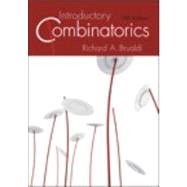
Introductory Combinatorics
by Brualdi, Richard A.-

This Item Qualifies for Free Shipping!*
*Excludes marketplace orders.
Buy Used
Rent Textbook
New Textbook
We're Sorry
Sold Out
eTextbook
We're Sorry
Not Available
How Marketplace Works:
- This item is offered by an independent seller and not shipped from our warehouse
- Item details like edition and cover design may differ from our description; see seller's comments before ordering.
- Sellers much confirm and ship within two business days; otherwise, the order will be cancelled and refunded.
- Marketplace purchases cannot be returned to eCampus.com. Contact the seller directly for inquiries; if no response within two days, contact customer service.
- Additional shipping costs apply to Marketplace purchases. Review shipping costs at checkout.
Summary
Author Biography
Table of Contents
| What is Combinatorics? | |
| Example: Perfect Covers of Chessboards | |
| Example: Magic Squares | |
| Example: The Four-Color Problem | |
| Example: The Problem of the 36 Officers | |
| Example: Shortest-Route Problem | |
| Example: Mutually Overlapping Circles | |
| Example: The Game of Nim | |
| The Pigeonhole Principle | |
| Pigeonhole Principle: Simple Form | |
| Pigeonhole Principle: Strong Form | |
| A Theorem of Ramsay | |
| Permutations and Combinations | |
| Four Basic Counting Principles | |
| Permutations of Sets | |
| Combinations of Sets | |
| Permutations of Multisets | |
| Combinations of Multisets | |
| Finite Probability | |
| Generating Permutations and Combinations | |
| Generating Permutations | |
| Inversions in Permutations | |
| Generating Combinations | |
| Generating r-Combinations | |
| Partial Orders and Equivalence Relations | |
| The Binomial Coefficients | |
| Pascal's Formula | |
| The Binomial Theorem | |
| Unimodality of Binomial Coefficients | |
| The Multinomial Theorem | |
| Newton's Binomial Theorem | |
| More on Partially Ordered Sets | |
| The Inclusion-Exclusion Principle and Applications | |
| The Inclusion-Exclusion Principle | |
| Combinations with Repetition | |
| Derangements | |
| Permutations with Forbidden Positions | |
| Another Forbidden Position Problem | |
| Möbius Inversion | |
| Recurrence Relations and Generating Functions | |
| Some Number Sequences | |
| Generating Functions | |
| Exponential Generating Functions | |
| Solving Linear Homogeneous Recurrence Relations | |
| Nonhomogeneous Recurrence Relations | |
| A Geometry Example | |
| Special Counting Sequences | |
| Catalan Numbers | |
| Difference Sequences and Stirling Numbers | |
| Partition Numbers | |
| A Geometric Problem | |
| Lattice Paths and Schröder Numbers | |
| Systems of Distinct Representatives | |
| General Problem Formulation | |
| Existence of SDRs | |
| Stable Marriages | |
| Combinatorial Designs | |
| Modular Arithmetic | |
| Block Designs | |
| Steiner Triple Systems | |
| Latin Squares | |
| Introduction to Graph Theory | |
| Basic Properties | |
| Eulerian Trails | |
| Hamilton Paths and Cycles | |
| Bipartite Multigraphs | |
| Trees | |
| The Shannon Switching Game | |
| More on Trees | |
| More on Graph Theory | |
| Chromatic Number | |
| Plane and Planar Graphs | |
| A 5-color Theorem | |
| Independence Number and Clique Number | |
| Matching Number | |
| Connectivity | |
| Digraphs and Networks | |
| Digraphs | |
| Networks | |
| Matching in Bipartite Graphs Revisited | |
| Pólya Counting | |
| Permutation and Symmetry Groups | |
| Burnside's Theorem | |
| Pólya's Counting formula | |
| Table of Contents provided by Publisher. All Rights Reserved. |
An electronic version of this book is available through VitalSource.
This book is viewable on PC, Mac, iPhone, iPad, iPod Touch, and most smartphones.
By purchasing, you will be able to view this book online, as well as download it, for the chosen number of days.
Digital License
You are licensing a digital product for a set duration. Durations are set forth in the product description, with "Lifetime" typically meaning five (5) years of online access and permanent download to a supported device. All licenses are non-transferable.
More details can be found here.
A downloadable version of this book is available through the eCampus Reader or compatible Adobe readers.
Applications are available on iOS, Android, PC, Mac, and Windows Mobile platforms.
Please view the compatibility matrix prior to purchase.
